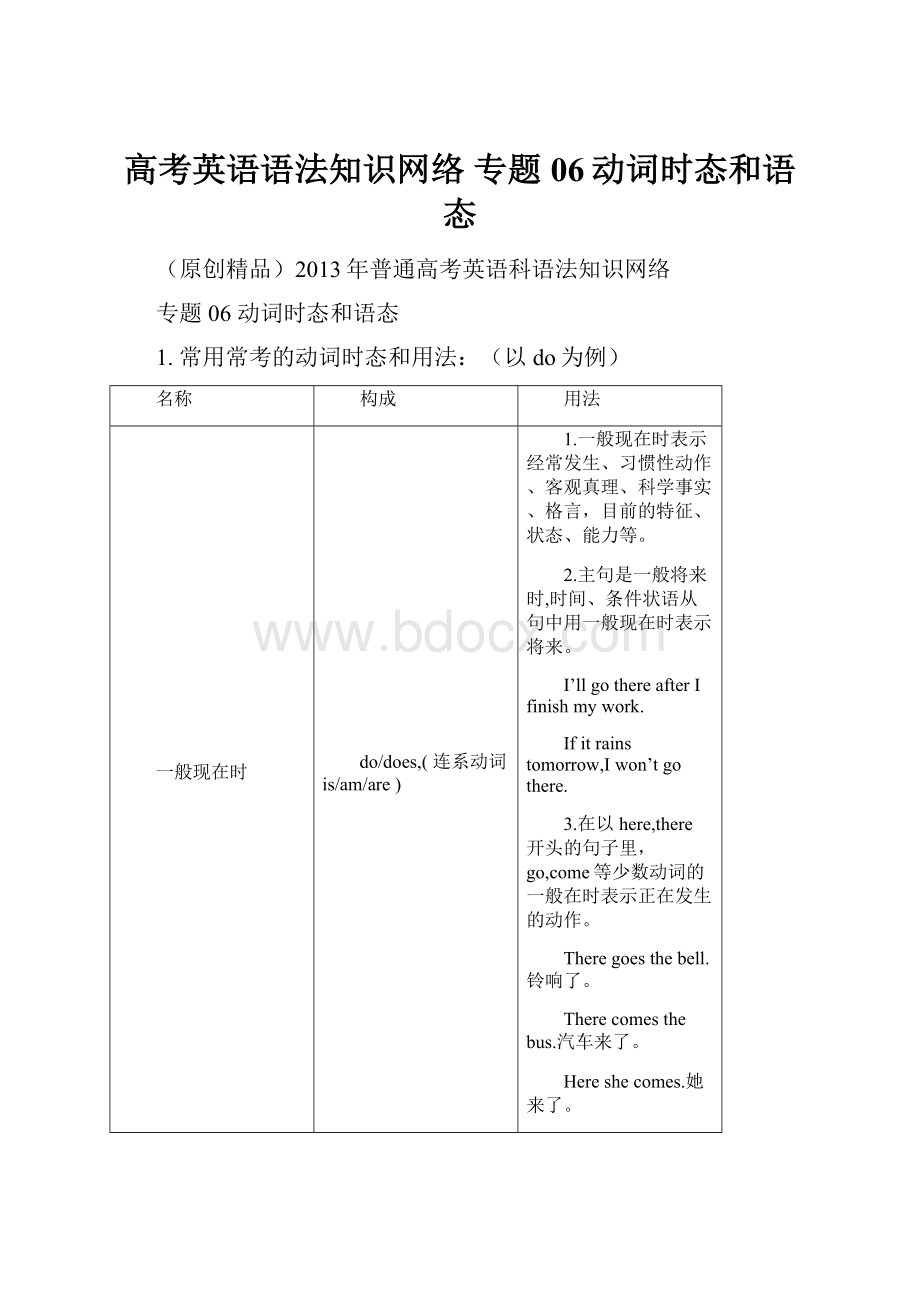高考英语语法知识网络 专题06动词时态和语态.docx
《高考英语语法知识网络 专题06动词时态和语态.docx》由会员分享,可在线阅读,更多相关《高考英语语法知识网络 专题06动词时态和语态.docx(13页珍藏版)》请在冰豆网上搜索。

高考英语语法知识网络专题06动词时态和语态
(原创精品)2013年普通高考英语科语法知识网络
专题06动词时态和语态
1.常用常考的动词时态和用法:
(以do为例)
名称
构成
用法
一般现在时
do/does,(连系动词is/am/are)
1.一般现在时表示经常发生、习惯性动作、客观真理、科学事实、格言,目前的特征、状态、能力等。
2.主句是一般将来时,时间、条件状语从句中用一般现在时表示将来。
I’llgothereafterIfinishmywork.
Ifitrainstomorrow,Iwon’tgothere.
3.在以here,there开头的句子里,go,come等少数动词的一般在时表示正在发生的动作。
Theregoesthebell.铃响了。
Therecomesthebus.汽车来了。
Hereshecomes.她来了。
一般过去时
did,(连系动词was/were)
表达特定的过去时间内发生的动作或存在的状况,或过去某一时间内经常发生或反复发生的动作或行为。
现在进行时
is/am/aredoing
1.表示正在进行的动作。
2.表示按计划安排即将发生的动作。
SheisleavingforBeijing.她要去北京。
Heisworkingasateachertomorrow.
从明天起他要做老师。
MyfatheriscomingtoseemethisSaturday.
这个星期六我爸爸要来看我。
3.代替一般现在时,描绘更加生动。
TheChangjiangRiverisflowingintotheeast.
长江江水滚滚向东流。
Thesunisrisingintheeast.太阳从东方冉冉升起。
过去进行时
was/weredoing
1.表示过去某一时刻或某一段时间内正在进行的动作(这一过去时间须用时间状语表示)
Hewaspreparinghislecturealldayyesterday.
2.表示动作在另一过去动作发生时进行
TheywerestillworkingwhenIleft.
3.用在两个过去进行时动作同时发生
IwaswritingwhilehewaswatchingTV.
4.表示过去将来动作
Hesaidshewasarrivingthenextday.
现在完成时
has/havedone
1.表示过去发生的动作对现在产生的影响或结果,说话时已
完成的动作。
Ihavefinishedthereport./Shehascleandtheroom.
2.表示从过去开始,待续到现在的动作或状态,往往
和“for...”,“since...”表述的一段时间状语连用。
HehaslearnedEnglishforsixyears.
Theyhaveworkedheresincetheyleftcollege.
3.表示“曾经到过某地(人已回来)”用“have/hasbeento”,表示“到某地去了(还未回来)”用“have/hasgoneto”。
—WhereisLiHua?
-Hehasgonetothereading-room.
—SheknowsalotaboutShanghai.
-Shehasbeenthere.
4.短暂动词(即瞬间动词),
join,lose,buy,borrow,leave,go,come,arrive,die,marry,finish,complete,begin,start,breakout等,在完成时态
中,其肯定式不能和表示一段时间的状语连用。
不能说:
Hehasjoinedthearmyforthreeyears.
要翻译“他已参军已经三年了。
”可采用
①“ago法”
Hejoinedthearmythreeyearsago.
②“延续法”
Hehasbeeninthearmyforthreeyears.
③“since法”
Itis/hasbeenthreeyearssincehejoinedthearmy.
过去完成时
haddone
1.表示在过去某一时间以前已经完成的动作。
Hehadshutthedoorbeforethedogcameup.
Everythinghadbeenallrightuptillthismorning.
2.表示动作或状态从过去某个时刻开始一直延续到
另一个过去时刻才完成,甚至还要继续下去。
Attheageoften,hehadlearned500Englishwords.
Hehadbeenillforaweekwhenwelearnedaboutit.
3.常用hope,expect,think,intend,want,suppose等动词的
过去完成时来表示未实现的希望、打算或意图。
Wehadexpectedthatyouwouldbeabletowinthematch.
将来完成时
will/shallhavedone
用来表示在将来某个时刻(前)将完成的动作。
常和by短
语,when,before引起的时间状语连用。
WewillhavefinishedseniorBook2bytheendofthisterm.
现在完成进行时
has/havebeendoing
用来表示从过去某一时刻开始一直持续到现在(还要继续下
去)的动作。
Hehasbeendoingthemathsproblemssince8:
00.
过去完成进行时
hadbeendoing
表示动作或状态从过去某个时刻开始一直延续到另一个过去时刻才完成,还将继续下去。
一般将来时
will/shalldo
is/am/aregoingtodo
is/am/are(about)todo
一般将来时表示将来要发生的动作和存在的状况
(详见下面2.一般将来时的特殊表达方式的比较)
过去将来时
would/shoulddo
was/weregoingtodo
was/were(about)todo
1.相对于过去某一时刻而言即将发生的动作或存在的状态
HetoldmehewouldgotoBeijing.他告诉我他将去北京。
Iwastoldthathewasgoingtoreturnhome.
有人告诉我他准备回家。
2.woulddo(表示过去的习惯)总是,总会,常常
Hewouldsitsilentforhours.
他常常接连好几个小时默默地坐着。
2.一般将来时的特殊表达方式的比较
将来时
用法
例句
1
be+doing进行时表将来
go,come,start,move,leave,arrive等词可用进行时表示按计划即将发生的动作
Heismovingtothesouth.
AretheyleavingforEurope?
2
beaboutto+动词原形
表示安排或计划中的马上就要发生的动作,后面一般不跟时间状语
Iwasabouttoleavewhenthebellrang.
Themeetingisabouttoclose.
3
beto+动词原形
表示按计划进行或征求对方意见
We’retomeetattheschoolgateatnoon.
4
一般现在时表将来
时刻表上或日程安排上早就定好的事情,可用一般现在时表示将来
Themeetingstartsatfiveo’clock.
Theplaneleavesattenthisevening.
3.容易混淆的时态比较
项目
区别
例句
一般过去时与现在完成时的比较
现在完成时强调过去动作对现在产生的影响或造成的结果
Wehaven’theardfromJaneforalongtime.Whatdoyousuppose_______toher?
A.washappeningB.happensC.hashappenedD.happened
说明:
说话者强调Jane目前的状况.
Mr.Lee,who________asacarpenterforover10years,isnowaveryfamousstatesmaninthiscountry.
A.hasworkedB.hadworkedC.workedD.works
(只说明他过去当过木匠不涉及到现在)
一般过去时只表达过去的动作或状态
Hello,I____youwereinLondon.Howlong_________here?
A.don’tknow;wereyouB.hadn’tknown;areyou
C.haven’tknown;areD.didn’tknow;haveyoubeen
说明:
didn’tknow强调见面前不知道
Ireadthenovellastmonth.(只说明上个月看了,不涉及现在是否记住)
现在完成时与现在完成进行时的比较
着重表示动作的结果时,用现在完成时
Ihavereadthatbook.我读过那本书了。
(知道那本书的内容)
着重表示动作一直在进行,即动作的延续性时,则用现在完成进行时
—Hi,Tracy,youlooktired.
—Iamtired.I_______thelivingroomallday.
A.paintedB.hadpainted
C.havebeenpaintingD.havepainted
说明:
强调动作从过去到现在的延续
现在进行时与过去进行时的比较
现在进行时表示现在某个时候或某段时间正在进行的动作
Idon’treallyworkhere.I____untilthenewsecretary_______.
A.justhelpout;comesB.havejusthelpedout;willcome
C.amjusthelpingout;comesD.willjusthelpout;hascome
说明:
指目前一段时间正在发生的动作,until引导的是时间状语从句,动词需用一般现在时。
过去进行时表示某个时候或某段时间正在进行的动作
—Hey,lookwhereyouaregoing!
—Oh,I’mterriblysorry._______.
A.I’mnotnoticing.B.Iwasn’tnoticing.
C.Ihaven’tnoticed.D.Idon’tnotice.
说明:
对话的后者显然是在解释刚才不小心冒犯对方时正在做的事情.
一般过去时与过去进行时的比较
一般过去时只表达过去的动作或状态
Tom________intothehousewhennoone___________.
A.slipped;wasnoticingB.hadslipped;noticed
C.slipped;hadnoticedD.wasslipping;noticed
说明:
slip和notice为同时发生的动作,因此B、C为错误选项,slipped指过去有结果的动作(他溜进去了),whennoonewasnoticing指他溜进去的一刹那发生的情况(没有人注意)。
过去进行时表示某个时候或某段时间正在进行的动作
.He______abookaboutChinalastyear,butIdon’tknowifhe______it.
A.wrote;hasfinishedB.waswriting;hasfinished
C.waswriting;hadfinishedD.wrote;willfinish
说明:
正确选项为B.从Idon’tknowifhehasfinishedit.推断,他去年一直在写。
II.动词的被动语态
常用被动语态
构成
常用被动语态
构成
1
一般现在时
am/is/aredone
6
过去进行时
was/werebeingdone
2
一般过去时
was/weredone
7
现在完成时
have/hasbeendone
3
一般将来时
shall/willbedone
8
过去完成时
hadbeendone
4
过去将来时
should/wouldbedone
9
将来完成时
will/wouldhavebeendone
5
现在进行时
am/is/arebeingdone
10
含有情态动词的
can/must/maybedone
注
意
事
项
被动语态的否定式是在第一个助动词或情态动词后加not,短语动词的被动态不可漏掉其中介副词。
固定结构begoingto,
usedto,haveto,hadbetter变为被动态时,只需将其后的动词变为被动态。
Treesshouldnotbeplantedinsummer.Theboywasmadefunofbyhisclassmates.
Newspapersusedtobesentherebythelittlegirl.
汉语有一类句子不出现主语,在英语中一般可用被动结构表示:
Itisbelievedthat…Itisgenerallyconsideredthat…Itissaidthat…
Itiswellknownthat…Itmustbepointedoutthat…Itissupposedthat…
Itisreportedthat…Itmustbeadmittedthat…Itishopedthat…
被动语态的句型
1.常见句式是:
主语(受动者)+be+过去分词+(by+施动者):
HewasscoldedbytheEnglishteacher.
2.主语+get+过去分词+其它成分:
Theboygotdrownedlastsummer./Shegotfiredbecauseofherfaults.
使用这种结构不能带有“by+施动者”
3.带有双宾语(直接宾语和间接宾语)的主动句变为动句,其主语可以是直接宾语,也可以是间接宾语。
Shelentmeabike.被动:
①Iwaslentabike(byher).②Abikewaslenttome(byher).
4.情态动词+be+过去分词:
Thisproblemmustbeworkedoutinhalfanhour.
5.双重被动式:
主语+被动式谓语+不定式的被动式+其它成分
Thesemagazinesarenotallowedtobetakenoutofthereading-room.
Themurdererwasorderedtobeshot.
下面主动形式常表示被动意义
1.不及物动词与状语连用,用以表示主语的品质和状态。
常见动词是:
cut,sell,read,write,fill,cook,lock,wash等。
Thisknifecutswell.这把刀好切。
Thesebookssellwell.这些书好卖。
Thepenwritessmoothly.这支笔写起来流畅。
Meatwon’tkeeplonginsuchhotweather.肉在这样热的天气里放不长久。
Theclothwasheswell.这种布好洗。
2.一些连系动词的主动式+形容词。
常见动look,smell,taste,sound,feel,prove,turnout等。
Theapplestastegood.Theflowersmellswonderful.
Thenewsproved/turnedouttrue.Cottonfeelssoft.
不可变为被动语态的几种情况
1.IteachmyselfFrench.不可变为MyselfistaughtFrench.因为反身代词不可作主语。
2.Wehelpeachother/oneanother.不可变为Eachother/Oneanotherishelpedbyus.因为相互代词不可作主语。
3.Helostheart.不可变为Heartwaslostbyhim.
因为象loseheart,makeaface,keepsilence,loseinthought这类动宾结构的固定短语只能用于主动式,不能用被动式。
4.Shetookpartinthesportsmeet.不能变为Thesportsmeetwastakenpartinbyher.
因为象takepartin,belongto,own,have,hate,fail,contain等表状态动词没有被动语态。
含有短语动词在被动语态中介词不能丢
Muchattentionmustbepaidtoyourhandwriting.
特别注意以下句子的结构:
EveryminutemustbemadefulluseoftostudyEnglsih.
下面词或短语没有被动态:
leave,enter,reach,become,benefit,cost,equal,contain,last,lack,fit,fail,have,appear,happen,occur,belongto,takeplace,breakout,comeabout,agreewith,keepupwith,consistof,haveon,loseheart等等